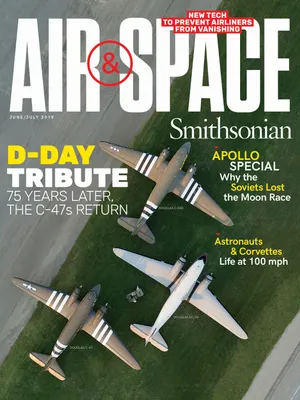This D-Day Veteran Earned Its Stripes
Museum conservators work to preserve historic markings on the B-26 Flak-Bait
:focal(4766x2698:4767x2699)/https://tf-cmsv2-smithsonianmag-media.s3.amazonaws.com/filer/74/3d/743de865-23cf-441a-9c49-b3710b3babfd/16d_jj2019_a19600297000_karenwings_cu_3202019_04_live.jpg)
The National Air and Space Museum’s Martin B-26 Marauder Flak-Bait still wears its original wartime paint, complete with chips, repairs, and patches testifying to the hard life of a combat aircraft. And it bears something else: invasion stripes—the black and white alternating bands on its wings and fuselage—applied for the D-Day invasion on June 6, 1944. It may be the only remaining aircraft in the world to boast such markings.
The first time markings were used to identify aircraft was at a bombing competition in Vienna in 1910, but it didn’t become common practice until World War I, in response to the critical need to distinguish between allies and enemies. A tension existed, however, between making national symbols large enough to facilitate identification, but not so large as to draw unwanted attention. As a result, ground gunners had difficulty seeing the marks and tended to fire at anything in the sky. Advances in aircraft speed and altitude only compounded this problem in World War II.
In advance of D-Day, the British had been experimenting with electronic identification, so-called “friend or foe” systems. But Allied planners believed the equipment would be overwhelmed by the large number of aircraft over the Normandy beaches. The planners decided that, in this case, recognition would be more important than concealment. What they needed was a bold, simple form of visual identification that would be easier to see than the standard national markings. They settled on five alternating white and black stripes (three white, two black) around the wings and rear fuselage.
Detailed orders described the exact dimensions of the stripes: 18 inches wide for single-engine and 24 inches wide for twin-engine aircraft. Secrecy was vital. If the Germans found out about the orders, they might copy the stripes and avoid Allied anti-aircraft fire. So the orders weren’t issued until just days before the invasion, when ground crews hastily applied the stripes with whatever paint and brushes were at hand. While some of the markings were carefully masked off to exact dimensions, period photographs attest to the often rough and uneven appearance of many of the applications.
/https://tf-cmsv2-smithsonianmag-media.s3.amazonaws.com/filer/57/06/57068121-1cd8-429e-9de2-404440d849fe/16a_jj2019_nasm-1b18390_live.jpg)
On the day of the invasion, Flak-Bait flew three separate missions, the first beginning in the early pre-dawn hours. The bomber would go on to fly 206 combat missions—more than any other U.S. aircraft. In 1946, it was crated and shipped back to the United States. Donated to the Smithsonian in 1949, the aircraft still wears its many battle scars. The forward fuselage was displayed in the Mall building for many years, but work is now under way to display the completely assembled Flak-Bait, at the Steven F. Udvar-Hazy Center in Virginia, for the first time since the end of World War II.
Preservation of the paint on Flak-Bait is a major concern. During the war, the U.S. Army Air Forces granted the Glenn L. Martin Company a waiver to skip primer when painting B-26s to save weight. Since primer helps paint adhere to bare metal—and without it, the paint easily chips—B-26s had an extremely weathered look. Museum conservator Lauren Horelick and Engen Conservation Fellow Karen Wilcox will work with scientists at the Smithsonian’s Museum Conservation Institute to identify the composition of the paint. Only anecdotal evidence currently exists as to the paint’s composition; correctly identifying it will provide an opportunity to add to the historical record.
Conservators are also interested in some disparities in the invasion stripes: Those on the right wing are even and appear to follow the regulations, while those on the left wing are not as distinct, and may have been repainted in slightly different positions.
As the 75th anniversary of D-Day approaches, Flak-Bait reminds all who see it of the sacrifices of those young men on the Normandy beaches.
